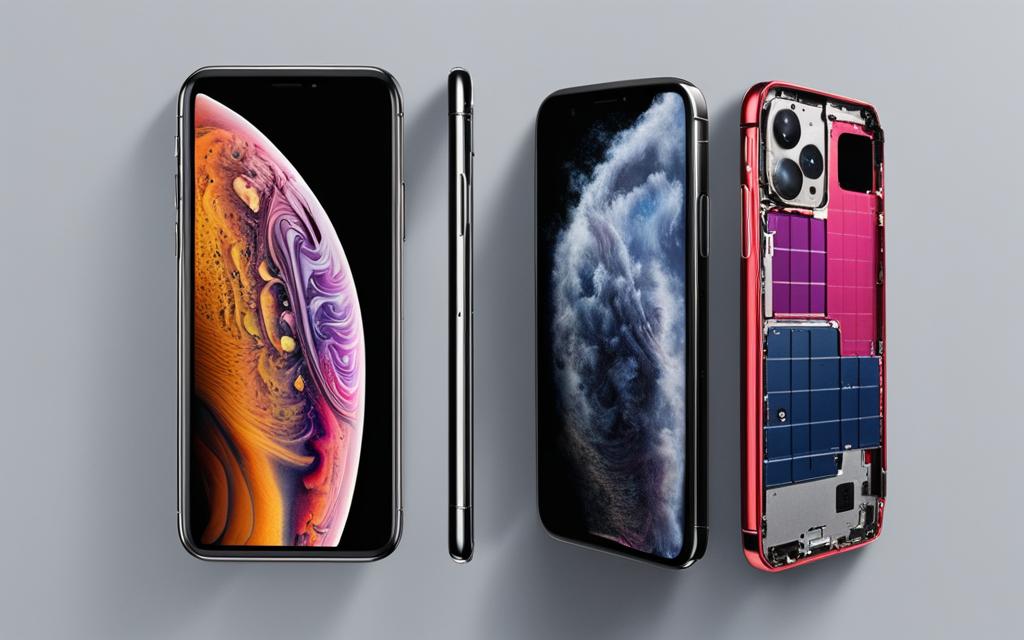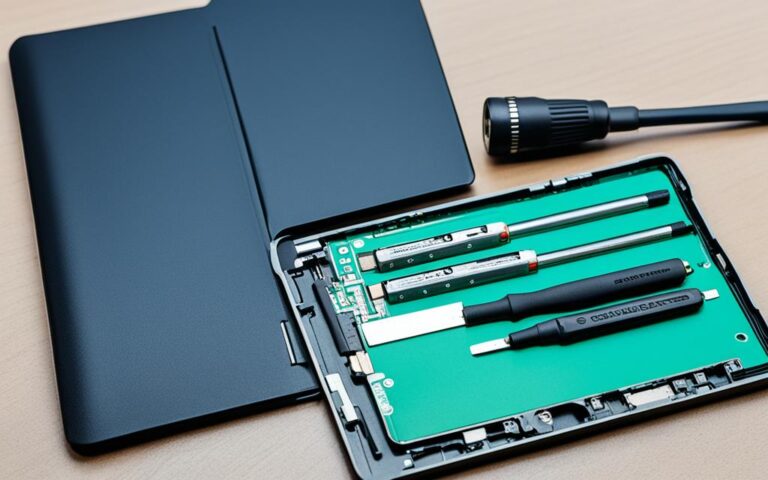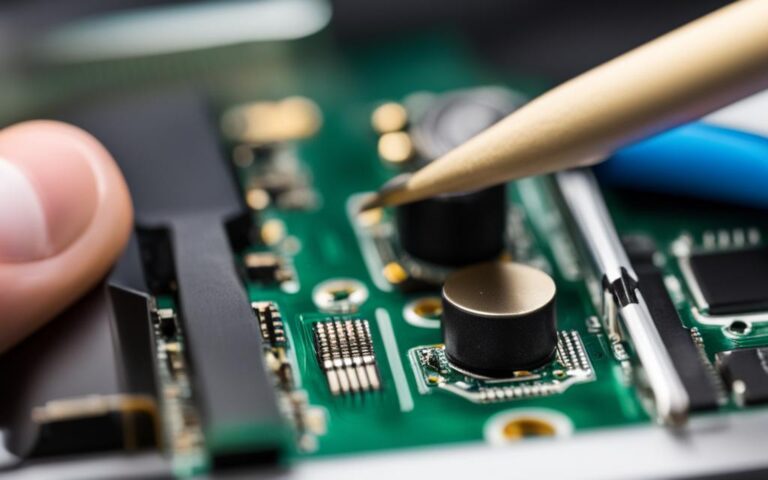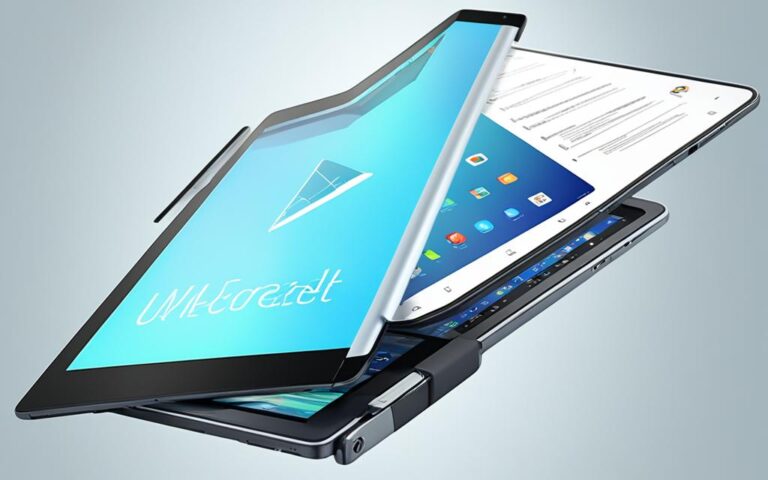Tablet vs Mac Mini: Repairability Comparison
When it comes to choosing electronic devices, repairability is an important factor to consider. It determines how easily a device can be fixed or upgraded when issues arise. In this article, we will compare the repairability of tablets and the Mac Mini, focusing on the tablet repairability and Mac Mini repairability scores.
Repairability scores provide valuable insights into how companies rate the repairability of their products. For Apple, these scores are self-reported and based on France’s repairability rating law. The scores cover five categories and sub-categories, including documentation, spare parts availability, spare parts pricing, and product-specific criteria. Apple’s repairability index currently includes smartphones and laptops, allowing for limited comparisons with other companies like Google, Samsung, and Microsoft.
Now let’s delve into the repairability scores for Apple iPhones and MacBooks, to see how they measure up in terms of repairability.
Repairability Scores for Apple iPhones
When it comes to repairability, Apple iPhones vary in their scores, with some models performing better than others. Let’s take a closer look at the repairability scores of popular iPhone models:
1. iPhone 7, iPhone 7 Plus, and iPhone 8
Among Apple’s iPhones, the iPhone 7, iPhone 7 Plus, and iPhone 8 have the highest overall repairability scores. These models are awarded the light green badges, indicating their excellent repairability. They score consistently in documentation, spare parts availability, spare parts pricing, and product-specific criteria.
| Repairability Criteria | iPhone 7 | iPhone 7 Plus | iPhone 8 |
|---|---|---|---|
| Documentation | 8/10 | 8/10 | 8/10 |
| Spare Parts Availability | 7/10 | 7/10 | 7/10 |
| Spare Parts Pricing | 7/10 | 7/10 | 7/10 |
| Product-Specific Criteria | 7/10 | 7/10 | 7/10 |
| Disassembly Score | 6/10 | 6/10 | 6/10 |
Note: Disassembly score reflects the ease of dismantling common parts.
2. iPhone SE (2020)
The iPhone SE (2020) ranks highest among Apple’s iPhones for its price ratio of spare parts to the phone itself. It offers better affordability in terms of repair components. However, it’s important to note that the overall repairability score is not the highest.
3. iPhone 12 range
The iPhone 12 range, although not the highest overall, boasts a high disassembly score. This indicates that common parts can be easily disassembled, making repairs more manageable. Apple continues to focus on improving the repairability of their newer models.
4. Older iPhone models
Older iPhone models like the iPhone X and iPhone XR have lower repairability scores, especially in spare parts pricing and disassembly. These models may pose more challenges when it comes to repairs and replacements.
Considering the repairability scores can help users make informed decisions when choosing an iPhone model that aligns with their repairability needs.
Repairability Scores for Apple MacBooks
The repairability scores for Apple MacBooks provide valuable insights into the ease of repairing these devices. Apple’s commitment to transparency is evident in its self-reported repairability scores, which are based on the repairability index implemented in France. Let’s take a closer look at the repairability scores for different MacBook models:
The 2017 MacBook Air
The 2017 MacBook Air has the highest repairability score among Apple’s MacBooks, earning a commendable 7 out of 10. This score is indicative of the device’s relatively better repairability compared to other MacBook models. Additionally, the MacBook Air’s disassembly score of 11.3 out of 20 demonstrates that it is relatively easier to access and dismantle the internal components, enhancing repair possibilities. Despite not being ideal, the high disassembly score contributes to the overall repairability of the 2017 MacBook Air.
The Newest MacBook Air with M1 Chip
Apple’s newest MacBook Air, equipped with the M1 chip, receives a repairability score of 6.5 out of 10. While slightly lower than the 2017 MacBook Air, this score still denotes a reasonable level of repairability. Users can expect a certain degree of ease when it comes to repairing this model.
The Intel-Powered MacBook Air 13
The Intel-powered MacBook Air 13 scores slightly lower in repairability compared to its M1 counterpart. However, it still offers a level of repairability that is on par with other MacBook models.
The 16-inch MacBook Pro
When it comes to the 16-inch MacBook Pro, it boasts a middling disassembly score. However, its price ratio of repair components is impressive, making repairs more affordable for users. This factor contributes to the device’s overall repairability.
The 2018 MacBook Pro
The highest-rated MacBook Pro in the repair index is the 2018 model. It outperforms the M1 MacBook Pro in terms of repairability, showcasing Apple’s continuous efforts to improve repair options for users. The 2018 MacBook Pro scores higher in the repairability index, ensuring that users have a higher chance of successfully repairing the device if necessary.
It’s important to note that while repairability scores may vary among MacBook models, in general, upgradability and repairability are limited across the entire lineup. Apple’s priority on sleek design and compactness often results in components being soldered to logic boards, making it challenging to upgrade or repair specific parts.
To summarize, Apple’s MacBook lineup encompasses a range of repairability scores. While some models offer better repairability than others, users should consider the overall limitations in upgradability and repairability before making their purchase decisions.
| MacBook Model | Repairability Score | Disassembly Score |
|---|---|---|
| 2017 MacBook Air | 7/10 | 11.3/20 |
| Newest MacBook Air with M1 Chip | 6.5/10 | N/A |
| Intel-Powered MacBook Air 13 | N/A | N/A |
| 16-inch MacBook Pro | N/A | Middling |
| 2018 MacBook Pro | N/A | N/A |
Repairability Scores for the M1-powered iMac
The M1-powered 24″ iMac has garnered praise for its sleek and compact design. iFixit’s teardown of the iMac provides valuable insights into its internal structure and repairability. The iMac features a relatively straightforward disassembly process, with screws securing most internal components. However, there are limitations to its repairability due to the lack of upgradability and the soldered M1 logic board. As a result, the iMac receives a repairability score of just 2/10, indicating that internal upgrades or repairs are nearly impossible.
While some components of the iMac are modular, the adhesive used to hold the glass display in place poses a challenge when accessing internal parts. This further hinders the ease of repair and limits the options for fixing or upgrading the device. Therefore, for those seeking a highly repairable device, the M1-powered iMac may not be the ideal choice.
Nevertheless, it is important to note that the M1-powered iMac’s limitations in repairability are balanced by its impressive performance and innovative features. The compact design and powerful M1 chip offer a seamless user experience, making the iMac a popular choice for those in need of a reliable desktop computer.
“The iMac receives a repairability score of just 2/10, indicating that internal upgrades or repairs are nearly impossible.”
While the M1-powered iMac may not be the most repairable Apple device, it showcases Apple’s commitment to pushing the boundaries of design and performance. The combination of aesthetics, power, and efficiency in the iMac makes it an attractive option for many users, despite its limitations in repairability.
Inside the Mac Mini: Improved Repairability
The 2018 Mac Mini is known for its relatively high repairability score of 6/10, making it a standout among other Apple devices. This score is attributed to several factors that contribute to its improved repairability.
-
Straightforward Disassembly: The Mac Mini features a straightforward disassembly process, allowing technicians to access internal components with ease.
-
User-Upgradable RAM: One notable aspect of the Mac Mini is its ability to have the RAM upgraded by users. This flexibility allows for customization and future-proofing the device.
-
Minimal Use of Adhesives: Unlike other Apple devices that heavily rely on adhesives to secure components, the Mac Mini utilizes minimal adhesives. This translates to easier repairs and reduced risks of damaging other parts during disassembly.
However, it’s important to note that certain components of the Mac Mini, such as the CPU, Apple T2 security chip, and storage, are soldered to the logic board. While this limits the upgradability of these specific parts, the repairability of other components remains intact.
The Mac Mini’s internal components, including the ports, are easily accessible, making it feasible for experts to perform DIY repairs. This accessibility, combined with the straightforward disassembly process, empowers users who have the necessary technical knowledge to undertake repairs.
Compared to other Apple devices, the Mac Mini offers a relatively high level of repairability, providing users with the opportunity to extend the lifespan of their device through repairs and upgrades.
Mac Mini Repairability Summary:
| Aspect | Repairability Score |
|---|---|
| Straightforward Disassembly | 8/10 |
| User-Upgradable RAM | 9/10 |
| Minimal Use of Adhesives | 7/10 |
| Component Upgradability | 5/10 |
Despite some limitations, the Mac Mini’s repairability score highlights its commendable design choices that prioritize accessibility and ease of repairs. This allows users to confidently perform maintenance on their devices or seek professional assistance without significant obstacles.
Comparing Repairability Scores
When comparing the repairability scores of Apple devices, it’s clear that there is variation across different product lines. The iPhone models generally have moderate repairability scores, with older models scoring lower. MacBooks, including the M1-powered iMac, have lower repairability scores due to limited upgradability and soldered components. In contrast, the Mac Mini stands out for its better repairability among Apple devices. Overall, the repairability of Apple products varies, and consumers should consider this factor when making tech choices.
| Device | Repairability Score |
|---|---|
| iPhone 7, iPhone 7 Plus, iPhone 8 | High |
| iPhone X, iPhone XR | Low |
| iMac (M1-powered) | Low |
| Mac Mini | High |
As shown in the table above, the repairability scores for different Apple devices vary. The iPhone 7, iPhone 7 Plus, and iPhone 8 have high repairability scores, indicating that they are relatively easy to repair. On the other hand, devices like the iPhone X and iPhone XR have lower repairability scores, making repairs more challenging. The M1-powered iMac also has a low repairability score, mainly due to its limited upgradability and soldered components. However, the Mac Mini stands out with a high repairability score, making it easier for users to repair and upgrade the device when necessary.
Considering repairability is essential when making tech choices. Devices with higher repairability scores offer more flexibility for repairs and upgrades, potentially reducing costs and extending the lifespan of the device. By choosing devices with better repairability, consumers can make more informed decisions and opt for products that align with their long-term needs and sustainability goals.
Conclusion
When comparing the repairability of tablets and the Mac Mini, it’s evident that the Mac Mini offers superior tech repairability. Despite limitations like soldered components, the Mac Mini’s straightforward disassembly process and user-upgradable RAM contribute to its higher repairability score. On the other hand, tablets, including Apple’s iPads, generally have lower repairability scores, making repairs and upgrades more challenging for users.
Considering repairability is crucial when making informed tech choices. Devices that are easily repairable or upgradable provide users with the flexibility to extend the lifespan of their gadgets and reduce e-waste. By opting for tech products with higher repairability scores, consumers can make sustainable choices and contribute to the preservation of valuable resources.
Repairability considerations also highlight the need for manufacturers to prioritize design practices that facilitate repairs. Building devices with modular components, accessible ports, and clear documentation can empower users to troubleshoot and fix issues independently. Additionally, transparent pricing and availability of spare parts enhance the repairability of devices, enabling users to return their gadgets to optimal functionality with minimal hassle.












